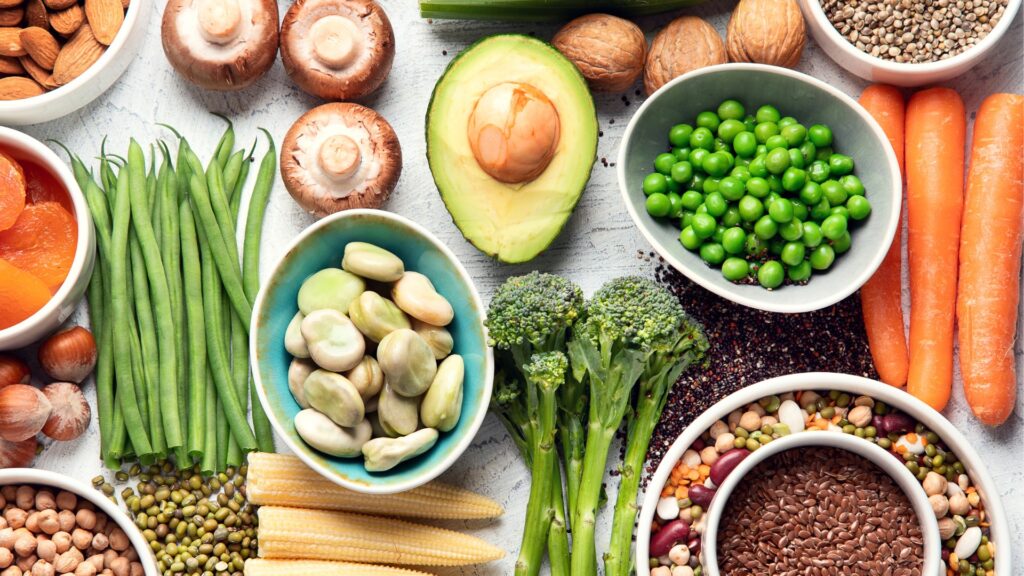A common misconception is that plants are poor protein sources, often due to the belief that some plants don’t contain “complete” proteins.
- A complete protein provides all nine essential amino acids.
- An incomplete protein lacks one or more of the nine essential amino acids.
Let’s begin by understanding these amino acids.
Protein, Amino Acids, and Your Body
Proteins are like Lego creations made from tiny building blocks called amino acids. Out of the twenty amino acids, nine are considered essential, meaning we must get them from food because our bodies can’t make them on their own. These amino acids can be arranged in so many different ways to build thousands of unique proteins. Each chain of amino acids twists, folds, and combines into different shapes to form a wide variety of proteins, each with its own important job.1 It’s this amazing flexibility that allows your body to grow, repair, and function every day.
In fact, amino acids play many important roles in keeping the body healthy. They help your body build and repair muscles, support a strong immune system, and protect your heart, nerves, and muscles from damage.2 Some amino acids also help your body make hormones and enzymes, balance fluids, support healthy bones, and even assist with movement and coordination.2 Together, these tiny molecules do big jobs that affect nearly every system in the body.
Animal proteins have all the nine essential amino acids and are therefore considered complete proteins. While all plant foods contain some protein, most are considered incomplete—though there are a few exceptions.3
Plant-Based Sources of Complete Protein
Plant foods that have complete protein are:
- Amaranth
- Some edible mushrooms (e.g. button, oyster, and shiitake)
- Blue-green algae (also called Spirulinia)
- Buckwheat
- Chia seeds
- Hempseed
- Quinoa
- Soy (edamame, miso, soy milk, tempeh, tofu).4,5,6,7,8
Even so, you don’t need to eat only plant foods with complete proteins to get all the amino acids your body needs to function properly. As long as you eat a mix of protein-containing plant foods such as grains, vegetables, legumes, nuts, seeds, and fruits throughout the day, your diet will likely provide all nine essential amino acids. This flexibility dispels the old myth of “protein combining” at each meal, which suggested that foods like rice and beans must be consumed together in the same meal.9 This concept, known as protein complementation, involves combining two incomplete plant protein sources to obtain all the essential amino acids. Examples of protein complementation include peanut butter on whole wheat bread, hummus with pita bread, corn chips with bean dip, and yogurt with nuts or seeds. What matters most, however, is total variety and adequate protein intake spread across the day.
Plant-Based Protein – Variety is Key!
You need to eat a variety of plant foods to get the amino acids your body needs from plant proteins. One of the best places to start is with legumes (beans, lentils, and peas), as well as nuts, seeds, and soy products.10 In fact, USDA MyPlate lists these foods among the protein group because they are excellent sources of plant protein, and provide antioxidants and key nutrients like fiber, potassium, iron and zinc.11 To guide your choices, here are some food examples in these categories from MyPlate:12
Beans, Peas, & Lentils | Nuts, Seeds, and Soy Products |
Bayo beans | Almonds |
Bean burgers | Almond butter |
Black beans | Brazil nuts |
Black-eyed peas | Cashew butter |
Brown beans | Cashews |
Chickpeas (garbanzo beans) | Chestnuts |
Cow peas | Chia seeds |
Edamame (young soybeans) | Flax seeds |
Falafel (spiced, mashed chickpeas) | Hazelnuts (filberts) |
Fava beans (broad beans) | Macadamia nuts |
Hummus (chickpea spread) | Mixed nuts |
Kidney beans | Peanut butter |
Lentils | Peanuts |
Lima beans (mature) | Pecans |
Mung beans | Pine nuts |
Navy beans | Pistachios |
Pigeon peas (gandules) | Pumpkin seeds |
Pink beans | Sesame butter or paste (tahini) |
Pinto beans | Sesame seeds |
Soybeans | Sunflower butter |
Split peas | Sunflower seeds |
White beans | Tempeh |
| Texturized vegetable protein (TVP) |
Tofu (made from soybeans) | |
| Veggie burgers (made from soybeans) |
| Walnuts |
MyPlate also lists specific amounts that count as 1 ounce-equivalents in the Protein Foods Group towards your daily recommended intake.
Beans, lentils, & peas (1-ounce equivalents)
- ¼ cup of cooked beans, peas or lentils (such as bayo, black, brown, fava, garbanzo, kidney, lima, mung, navy, pigeon, pink, pinto, or soy, or white beans, or black-eyed peas, or split peas, and red, brown, and green lentils)
- ¼ cup of baked beans or refried beans
- ¼ cup of frozen edamame (young soybeans)
- 1 falafel patty (2 ¼”, 4 oz)
- 6 tablespoons hummus10
Nuts, seeds, & soy products (1-ounce equivalents)
- ½ ounce of nuts (12 almonds, 24 pistachios, 7 walnut halves)
- ½ ounce of seeds (chia, flax, pumpkin, sesame, sunflower, or squash seeds) hulled, roasted
- 1 tablespoon of almond, cashew, peanut, or sunflower butter, or sesame paste (tahini)
- ¼ cup (about 2 ounces) of tofu
- 1 ounce tempeh, cooked10
Keep in mind that portion size matters – especially with nuts, seeds, and legumes. Nuts and seeds are rich in healthy fats and calories, while legumes have more carbs but similar protein; small handfuls or spoonfuls can add nutrition without overdoing it.13
Rounding Out Your Diet with Plants
Although fruits and vegetables typically contain less protein than legumes or nuts, many still contribute meaningful amounts – along with a wealth of vitamins, minerals, and fiber. For example, a cooked cup of broccoli or Brussels sprouts offers around 5–6 grams of protein, while whole grains like wild rice and oats provide about 6 grams.14 Quinoa and amaranth deliver even more, with roughly 8 and 9 grams protein per cooked cup, respectively, plus key nutrients like iron, magnesium, and folate.14 Including a variety of plant foods can help round out your protein intake while delivering antioxidants and essential micronutrients.
Want to find the protein in your food? Use the USDA FoodData Central search feature. This list from Today’s Dietician may also be a helpful starting place.
Looking for a little motivation to add more fruits and vegetables to your diet? Try the 10 & 10,000 Change Challenge – our free web-based application to help you progress gradually through 4 stages of lifestyle transformation over 100 days to meet recommended diet and physical activity guidelines.
References
- Arizona State University, School of Life sciences. Amino acids: Ask A biologist. Accessed July 28, 2025. https://askabiologist.asu.edu/venom/building-blocks-protein.
- Langyan S, Yadava P, Khan FN, Dar ZA, Singh R, Kumar A. Sustaining protein nutrition through plant-based foods. Frontiers. July 26, 2025. Accessed July 28, 2025. https://www.frontiersin.org/journals/nutrition/articles/10.3389/fnut.2021.772573/full.
- Williamson L. Protein in plants? it’s in there – and here’s Why you should try it. www.heart.org. February 26, 2025. Accessed July 28, 2025. https://www.heart.org/en/news/2025/02/26/protein-in-plants-its-in-there-and-heres-why-you-should-try-it.
- Martinez D. Adding plant-based proteins to your Diet. Cooper Aerobics. May 28, 2025. Accessed July 28, 2025. https://www.cooperaerobics.com/blog/Plant-Based-Protein-Possibilities/.
- Pashaei, K. H. A., Irankhah, K., Namkhah, Z., & Sobhani, S. R. (2024). Edible mushrooms as an alternative to animal proteins for having a more sustainable diet: a review. Journal of Health, Population and Nutrition, 43(1), 205.
- Tavakoli, Z., Kavoosi, G., Siahbalaei, R., & Karimi, J. (2025). Spirulina maxima as a valuable ingredient: Determination of broad fatty acid and amino acid profiles and nutritional quality and anti-amylase capacity. Applied Food Research, 100741.
- Cleveland Clinic. What’s a complete protein and should you care? Cleveland Clinic. April 22, 2025. Accessed June 12, 2025. https://health.clevelandclinic.org/do-i-need-to-worry-about-eating-complete-proteins.
- McGrane K. Vegan complete proteins: 13 plant-based options. Healthline. May 28, 2024. Accessed June 12, 2025. https://www.healthline.com/nutrition/complete-protein-for-vegans.
- Lee J. Are plant proteins complete proteins? Consumer Reports. February 25, 2017. Accessed July 28, 2025. https://www.consumerreports.org/diet-nutrition/are-plant-proteins-complete-proteins/?msockid=3b999093c0df64fb1981825bc17e6557.
- MyPlate U.S. Department of Agriculture. Protein foods. Accessed July 28, 2025. https://www.myplate.gov/eat-healthy/protein-foods.
- MyPlate U.S. Department of Agriculture. Beans, peas, and Lentils. Accessed July 28, 2025. https://www.myplate.gov/eat-healthy/protein-foods/beans-peas-lentils.
- MyPlate U.S. Department of Agriculture. Food Group Gallery. Accessed July 28, 2025. https://www.myplate.gov/eat-healthy/food-group-gallery#protein-foods.
- Harvard Medical School. Plant-based diet: Nuts, seeds, and legumes can help get you there. Harvard Health. November 13, 2014. Accessed July 28, 2025. https://www.health.harvard.edu/staying-healthy/plant-based-diet-nuts-seeds-and-legumes-can-help-get-you-there.
- U.S. Department of Agriculture, Agricultural Research Service. (2024). FoodData Central. https://fdc.nal.usda.gov/.


